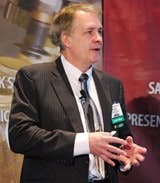Safety Offers Sustainability, Productivity Benefits
Safety is always critical, but it also can go beyond itself, securing a home within larger productivity and sustainability efforts. This is no coincidence because, as control and automation operations and networks come together into more closely integrated systems, they're also drawing previously segregated safety capabilities into their orbit. In part, this is a result of National Fire Protection Association rules (NFPA-79) that now allow regular data and safety communications to occur on the same network, but it's also because many international, regional and national safety standards are resolving their differences and harmonizing their requirements to help machine builders and users apply safety practices consistently.
"Safety, sustainability and productivity are all weaving together," said Michael Douglas, senior manager for new technology and standards at General Motors. Douglas delivered his keynote presentation, "How Safety Impacts Sustainability," at the second annual Safety Automation Forum on Nov. 10, the day before the opening of Rockwell Automation's Automation Fair 2009 at the Anaheim Convention Center.
"As you may know, a lot changed at GM in the past year and at the other major auto manufacturers as well," said Douglas. "The new GM has a much lower break-even point, but we're still in 140 countries and run manufacturing plants in 34 countries, and, as of last Thursday or Friday night, we're keeping Opel, too. The new GM means customers, cars and culture, which is contained in even more customer and product focus, speed, accountability and risk taking—which does not mean being unsafe. As before, safety is our overriding priority."
This devotion to safety is manifest in GM's eight main enterprise blocks, which include its research department; proving ground support; product and manufacturing system design; manufacturing assembly, test and repair; field/repair dealerships; consumer support; audit modules; and functional technical expert support.
Douglas reported that any new idea that bubbles up within these organizational blocks is affected by four sub-groups: leaders, integrators, creators or designers, and producers. At GM, integrators are the execution teams and suppliers, creators are its global engineering centers, and producers are its plant-floor facilities. Also, new ideas are implemented in four time-based steps, from innovators and early adopters through early majority adopters, late majority adopters and laggards. He explained these steps happen in each of the four organizational sub-groups. Douglas added that Malcolm Gladwell's principles of "stickiness" and "power of context" in his Tipping Points book also applies to some of the safety and productivity efforts that GM began in 1992.
Consequently, in 2005, GM developed a two-stage approach to capture the multiple actions required for safety applications. Douglas added that it overcomes the typical flaws in the traditional hierarchy-of-controls safety approach, which involves eliminating or substituting risks, engineering controls, implementing administrative controls such as awareness devices and signs, training and procedure, and personal protective equipment. Similarly, the first stage of GM's iterative, two-stage approach seeks to eliminate hazards by changing tasks, functions or locations, or by substituting materials. The second stage reduces risks to a safe and acceptable level by balancing a combination of actions in five categories:
- Engineering controls,
- Awareness, including warnings, signs and other devices,
- Safe operating procedures,
- Training of operators, maintenance staff and others, and,
- Personal protective equipment.
Douglas added that the two-stage approach can be applied to everything from training to sustainability to productivity. Likewise, users need to apply the five essential areas of risk assessment, which are observations, issues, analyses, impact and risk-reduction actions. At GM, this means going through four gates, which are kickoff, safety and design review, performing the risk assessment, validation and final buyoff. "What's even more important here is to have participants at each gate establish communication paths between their areas and talk to each of the others," said Douglas. "Fortunately, engineers trained in the two-stage approach bring their experience to each of their next projects or programs." He added that GM has completed 14,000 risk assessments for itself and its suppliers since 1997.
"For instance, because we're building the batteries for our new Chevrolet Volt vehicles ourselves, we recently used our two-stage approach on risk assessment to reduce the costs at the design stage of cutting the die, and we saved $360,000," explained Douglas. "In addition, because of this past year's financial struggles, we took some of our old equipment and shipped it to where we're building our new Volt autos, and we've been using Rockwell Automation's Smart Guard 600 controllers to get our old and new safety systems to talk together better."
Douglas added that the two-stage approach is next incorporated into the middle of GM's "Cake Chart," which contains 35 steps and eight feedback paths, supporting its seven life-cycle areas, which are design concept, preliminary design, detailed design, build or purchase, commission, production/maintenance and decommission. Douglas said the cake chart can help users know where they are, where they're going, find the best new/reuse options, optimize costs, achieve greater value and determine how confident they are that their systems are safe. For example, he added that GM saved about $3.8 million per year by using cake chart-based improvements to make four extra trucks per day at each of five plants—and did it while maintaining or improving its safety levels at the same time.


